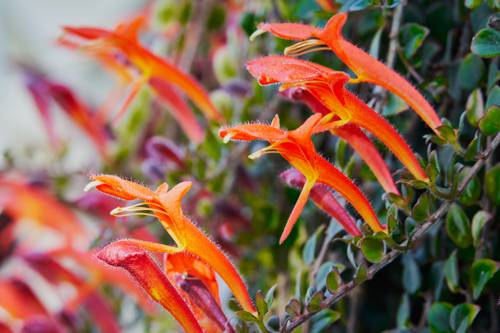
FAQ About Epiphytic Indoor Plants

What are epiphytic indoor plants?
Epiphytic indoor plants are plants that grow on other plants for support but are not parasitic. They derive their moisture and nutrients from the air, rain, and sometimes debris accumulating around them. Common examples include orchids, bromeliads, and certain types of ferns.

How do epiphytic plants differ from regular indoor plants?
Epiphytic plants differ from other indoor plants primarily in their growth habits and nutrient uptake. They grow on surfaces like tree trunks, rocks, or specially designed mounts in the home and absorb nutrients and moisture from the environment around them, rather than from soil.

What types of structures can be used for mounting epiphytic indoor plants?
Common structures used for mounting epiphytic indoor plants include wooden boards, cork bark, or wire frames. These provide support and allow the plants to mimic their natural growing conditions. Moss or other moisture-retaining materials are often added to these mounts to provide additional humidity and nutrients.

How often should epiphytic plants be watered?
The watering needs of epiphytic plants vary based on their species, environment, and mounting type. Generally, they should be watered every few days in a dry indoor environment. It's crucial to allow them to dry out between waterings to prevent root rot. Misting can also provide necessary humidity.

Do epiphytic indoor plants need special fertilizers?
Yes, epiphytic indoor plants benefit from specialized fertilizers. Fertilizers should be water-soluble and balanced, or formulated specifically for epiphytes, like orchid or bromeliad fertilizer. It's important to apply them at half strength to avoid nutrient burn, typically once a month during the growing season.

Can all epiphytic plants be grown indoors?
While not all epiphytic plants can be grown indoors, many common varieties are well-suited for indoor environments, especially those that thrive in indirect light and do not require complex care. It's important to consider the specific needs of each plant type with regard to light, humidity, and space.

What lighting conditions do epiphytic indoor plants prefer?
Most epiphytic indoor plants prefer bright, indirect light. Direct sunlight can be too harsh, causing leaf burn. A location near an east or north-facing window is often ideal. However, lighting conditions may vary based on specific plant species.

How can I provide adequate humidity for my epiphytic plants indoors?
To provide adequate humidity, consider misting the plants regularly, using a humidity tray filled with water and pebbles, or placing a humidifier nearby. Grouping plants together can also naturally increase the humidity level through transpiration.

Are epiphytic indoor plants easy to care for?
Many epiphytic indoor plants are relatively easy to care for once their basic requirements are understood. They often require less frequent watering than soil-based plants and can adapt to lower light conditions. However, attention to humidity and occasional fertilization is necessary for healthy growth.

What are some common epiphytic indoor plant species?
Common epiphytic indoor plant species include orchids (such as Phalaenopsis), bromeliads (like Tillandsia), staghorn ferns, and some peperomia. Each species has unique care requirements but generally follows the epiphytic care principles.

Can epiphytic plants be grown in traditional pots?
Yes, some epiphytic plants can be grown in traditional pots filled with specialized epiphyte mix, which mimics their natural environment. The mix generally includes materials like bark, sphagnum moss, or perlite to facilitate drainage and airflow.

What are the common pitfalls of caring for epiphytic indoor plants?
Common pitfalls include overwatering, inadequate light, and insufficient humidity. Overwatering can lead to root rot, while too little light can hinder their growth. Ensuring proper air circulation is also crucial to avoid fungal diseases.

How do you know if an epiphytic indoor plant is healthy?
A healthy epiphytic indoor plant should have vibrant, strong leaves and steady growth. Signs of ill health include yellowing or wilting leaves, stunted growth, or an absence of new growth. Regular inspection can help catch these issues early.

Can epiphytic plants survive in low-light conditions?
While some epiphytic plants can tolerate low-light conditions, their growth may slow down without sufficient indirect sunlight. For optimal health, these plants should be placed in bright, indirect light or have supplemental lighting if natural light is insufficient.

Do epiphytic indoor plants attract pests?
Epiphytic indoor plants can attract pests like any other indoor plant, including aphids, mealybugs, and spider mites. Regularly inspecting the plants and maintaining proper hygiene can help prevent infestations. If pests are found, natural remedies like neem oil can effectively control them.

How do I repot an epiphytic plant?
When repotting an epiphytic plant, gently remove it from its current mount or container, being careful not to damage the roots. Prepare a new mount or container with fresh epiphyte mix if needed. Secure the plant, ensuring it is firmly attached but not suffocated. Water thoroughly after repotting.

Can you propagate epiphytic indoor plants?
Yes, many epiphytic indoor plants can be propagated. Common methods include division of offsets or pups (for bromeliads) or cutting a section of rhizome (for certain ferns). Ensure that each propagated piece has roots or nodes for successful growth, and treat it with care until well-established.

Are there specific temperature requirements for epiphytic indoor plants?
Most epiphytic indoor plants prefer temperatures ranging from 60°F to 75°F (15°C to 24°C). They typically do not tolerate frost or extreme heat. Keeping them in a stable indoor climate will support healthy growth and flower development, depending on the species.

How do epiphytic plants adapt in their natural habitat?
In their natural habitat, epiphytic plants adapt by growing on trees or other structures to reach sunlight and gather moisture from the air. They have developed specialized root structures to anchor themselves and absorb nutrients and water directly from the air and rain.

What is the role of roots in epiphytic plants?
In epiphytic plants, the roots primarily serve as anchorage to their host plant or other surfaces. They also aid in absorbing moisture and nutrients from the environment rather than assuming a conventional role of gathering from soil. These specialized roots can often be seen clinging to or wrapping around branches or mounts.
